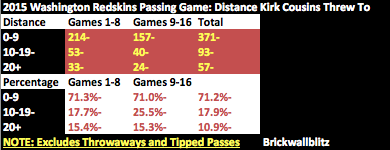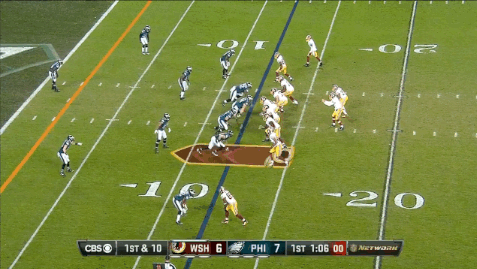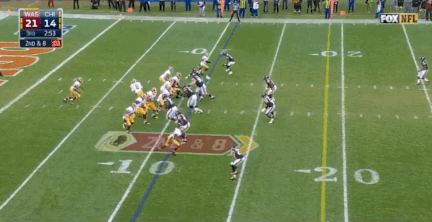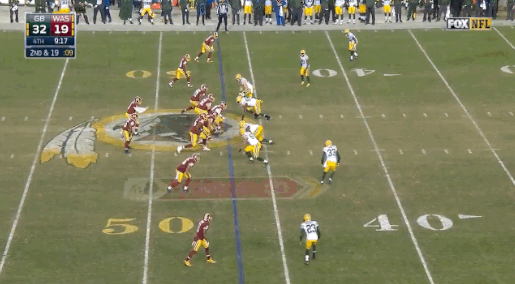After clinching the NFC East division for the first time since 2012, the Washington Redskins with quarterback Kirk Cousins appear to have finally found stability as a franchise.
Is Quarterback Kirk Cousins Holding the Washington Redskins Back?
After then starting quarterback Robert Griffin III suffered a concussion during a preseason game against the Baltimore Ravens, head coach Jay Gruden decided to make a switch in starters. This gave backup Kirk Cousins the job for the entire 2015 season.
In his first six starts Washington went 2-4, with Cousins throwing six touchdowns and eight interceptions. Many called for Kirk to be benched, but Gruden stuck with him, and it apparently paid off. In the last ten games of the regular season, Cousins threw 23 touchdowns to three interceptions. The ‘Skins went 7-3 in that stretch before losing at home to the Green Bay Packers in the Wild Card round of the playoffs.
In total, Cousins lead the National Football League in completion percentage (69.8%) while throwing for 4,166 yards, 29 touchdowns, and 11 interceptions for a 101.6 passer rating. His 74.8 completion percentage at home is an NFL record.
Normally, this would demand a huge extension and a lockdown of Cousins as the franchise quarterback. But Washington has chosen not to bite the bullet, putting the franchise tag on Cousins instead. Worth $19 million, the tag gives the franchise the chance to see if Cousins can back up his impressive statistics from the second half of the 2015 season.
But while his production brought the Redskins to the playoffs, did Cousins’ quality of play change significantly over the second half of 2015?
To examine this, every throw Cousins made during the 2015 regular season was examined. They were split into distances of 0-9, 10-19, and 20+ air yards, and split into two halves (Games 1-8 and Games 9-16). Throwaways and passes tipped at the line of scrimmage were excluded.

As you’ll notice, the percentage of passes by distance remained near identical in the first and second halves. So the change in Cousins’ stats did not come from a change in decision making. So what happened?
Defenses could not capitalize on Cousins’ mistakes.
Cousins played better in the second half, and played relatively well in games like Week 15 against Buffalo and Week 16 at Philadelphia, but otherwise it was mostly the same as his first-half production.
What really should be credited is the quality of the players around Cousins. Under new offensive line coach Bill Callahan, the pass protection improved greatly, giving Cousins plenty of time in the pocket. The run game featured Alfred Morris and rookie Matt Jones, who broke out on several yards after catch plays.
But it’s the receiving corps that deserves the most credit. DeSean Jackson is able to create plenty of space and is one of the league’s top slot receivers. Pierre Garcon reeks of equal quality, and rookie Jamison Crowder offered elusiveness and a dangerous yards after catch threat. Jordan Reed was the clear primary target for Cousins, and the tight end’s skill set is awe inspiring. His strength and footwork allow him to barge past defenders and gain more yards than thought possible.
The Redskins played a dink and dunk offense in 2015, set on creating yards after the catch while minimizing the amount of difficulty Cousins had to make with his throws. Many of these completions were by design, and his only requirement was to simply get the ball to his receiver and let him do all the work.
In Week 10 against the New Orleans Saints, all Cousins had to do was just show up on the field. The Saints defense was abysmal in 2015, giving up 4,544 passing yards and 45 touchdowns, including four to Cousins.


On the first play, a 78-yard dumpoff to Jones, all Cousins has to do is loft the ball into Jones’ area. Jones gets a cakewalk into the end zone thanks to the Redskins blocking and the poor coverage from the Saints defense. In the second play, Cousins makes a simple screen to Crowder, who shows off excellent speed and makes it a 31-yard play.
Both plays required little impact from the quarterback, while the blocking and receivers delivered.



On each of these three plays, Cousins makes an easy pass to Jordan Reed, whose size and strength allows him to make all three of these catches. Additionally, all three are played out by design.
As the second half of the season went on, Cousins did manage to throw some good passes in the back of the end zone, but it was largely in between. Even Cousins’ downfield completions aren’t anything to write home about, although his go ahead touchdown to Jackson against the Cowboys on Monday Night Football deserves a mention.
Cousins played well enough inside the scheme over this stretch, but played dangerously on occasion.



Kirk Cousins is a quarterback with exceptionally limited vision. He does not survey the field before making a throw and tends to stare his receivers down or rush the ball far too early. On the first play, against the New York Giants in a clean pocket, Cousins does not see that Dominique Rodgers-Cromartie is staring him down when looking for Jackson, and fires a horrible dropped interception that falls right out of the cornerback’s hands. The Giants would get the ball back two plays later, only to fail to capitalize on both Cousins’ throw and the stop. New York would end up losing the game.
The second play, during a game at the Chicago Bears, was intercepted, and like the previous one, it was awful. Again from a clean pocket, Cousins rushes a throw to Garcon, and Kyle Fuller plays it perfectly for the easy interception. The Bears would end up tying the game on the ensuing drive.
The third play, also from the Chicago game, is the worst of the three. Cousins isn’t the most mobile quarterback, but he does a great job of buying time on this play. The result, however, is one of the worst completed passes I have ever seen. On a third and 6, up 24-21 with about four minutes remaining in the fourth quarter, a floater is the last thing a team wants. This play could have easily been intercepted, but Jones (who should have been thrown to in the flat on the same play), somehow came down with the catch after the ball was flipped around like a hot potato, bailing out Cousins.
As seen from this last play, Cousins also tried too hard to extend the play throughout the 2015 season, and these plays were often unsuccessful.
During the playoff game against the Packers, the Redskins were facing an inferior team that had suffered from flawed running and receiving games. Washington had several opportunities to put daggers on the Packers early in the game but failed.

On this play, Cousins’ pass is inaccurate, and corner Casey Hayward has his eyes on a pick six. Reed, however, makes an incredible one-handed catch, bailing Cousins out while gaining 20 yards on the play.
Otherwise, Cousins played a good first half, but saved some of his worst for the second half; more specifically, the fourth quarter.
Down 32-19, the Redskins had several opportunities to make the game closer, and whiffed. Most of this had to do with Cousins’ decision making.

On this broken up play, Cousins forces another near interception in the direction of Jackson, but the two Packers defenders collide into each other, again bailing Cousins out.

On this play, the Redskins face a third and long, desperate for a big play. Cousins drops back to pass, but fires far too late to Reed. Making things worse is that the pass is wide of the tight end, so the Redskins are forced to punt.
This particular play is wrenching because Cousins should have thrown to Reed as he was cutting to the sideline. Cousins is not a guy that regularly throws when his receivers are open, though, so he fires it late and wide. It may not have felt like much even if Reed had gotten it, but it would have given Washington better field position to either kick a field goal and make the game closer, collect the first down, or go for it on fourth down.
As you may have also noticed, running back Chris Thompson is also open in the flat of the right side, waving his hands up. There is no one near him, so he also has plenty of room to give the Redskins better field position, yet is not considered.

Cousins’ hesitation and limited field vision come to haunt him again on this play. Thompson is wide open in the flat again for a potential big gain, but Cousins also does not see him on this play. Instead, he hesitates, then awkwardly limps a dying pass to Reed, which is easily broken up. The mechanics on this pass are so bad that I thought the GIF was in slow motion at first.

Lastly, in a situation where you have to score quickly, this is unacceptable. This is the perfect situation to throw up a Hail Mary in the end zone, regardless of whether it’s picked or not. At this point in the game, desperate times call for desperate measures.
Naturally, Cousins does the opposite of what he should do, scrambling and holding onto the ball for far too long while taking the sack and turning the ball over on downs. At this point in the game, the Packers lead is safe for good.
Kirk Cousins is a limited quarterback. He needs a great cast of receivers around him to mask his flaws, and his decision making is not up to the level of a franchise quarterback at this point in his career. Apparently the Redskins management feels the same, as they drafted Texas Christian University receiver Josh Doctson, further giving Washington wide receiver depth.
Many people agree that the Redskins got by in the NFC East due to injuries division rivals suffered, as well as an easy schedule. The team is winless in Cousins’ starts against winning teams, but they’ll have plenty of opportunities next season, as they face a tough schedule in 2016. This includes teams like the Pittsburgh Steelers, Ravens, Arizona Cardinals, Cincinnati Bengals, Minnesota Vikings, Packers, Carolina Panthers, and Bears.
Needless to say, the pressure is on for Cousins to prove that his 2015 season was not a fluke. He must limit the mistakes for the Redskins to have a shot at reclaiming the NFC East division. Otherwise, he can say goodbye to the franchise extension.
Main Photo:





